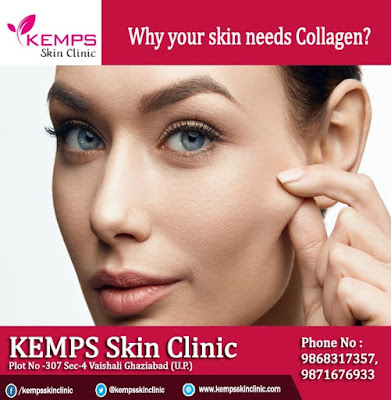Collagen is the most abundant structural protein found in
our bodies and our skin. Collagen is the most abundant protein in your
body. It is the major component of connective tissues that make up several body
parts, including tendons, ligaments, skin and muscles. Collagen has
many important functions, including providing your skin with structure and
strengthening your bones It’s literally the glue that holds us together.
It acts as the foundation for your bones, teeth, muscles, skin, and pretty much
all other connective tissues. Collagen makes up more than one-third of your
total protein and works to firm your skin and strengthen your bones.
Type II - is found in cartilage and the eyes.
Collagen is rich in the amino acids or building blocks
otherwise known as - glycine, proline, and hydroxyproline - that help your body to make new collagen. There are at least 28 different types of collagen but
types I, II, and III form around 80-90% of the collagen found in your
body.
Types I and III - provide structure to your skin, muscles
and ligaments.
Type II - is found in cartilage and the eyes.
The type of collagen that keeps you looking youthful is
found in the middle layer (dermis) and makes up nearly 80% of your skin. It
works together with elastin to strengthen the skin and help it snap back into
place when stretched. Think of it like a tightly coiled spring mattress that
gets saggy with age and use.
WHY DO YOU NEED COLLAGEN?
Your body naturally produces collagen every day but as we
age, collagen production gradually slows down. At around 25, the enzyme
collagenase that’s found in your skin, breaks down collagen faster than you can
make it. Every year thereafter, you start losing between 1-2% of your collagen.
By the time you reach your 40's, you've lost 30% of your collagen supply. If
you were to view your skin under a microscope you would see the fragmentation of
the collagen network in the dermis - aka lines and wrinkles.
There are also other extrinsic and intrinsic factors at work
that contribute to skin aging- ultraviolet (UV) rays from sun exposure,
smoking and cross-link glycation from sugar and inflammation. These all
activate enzymes that degrade your collagen fibers.
WHY YOUR SKIN NEED COLLAGEN?
Collagen is the most abundant protein in your body, tasked
with holding your entire body together, much like glue. You find it in the
connective tissue in your skin, hair, joints, bones, muscles and more. Collagen
is one of those rare things that really can help you age backward. All those
pricey anti-aging treatments at your dermatologist’s office, like lasers and
ultrasounds, work by stimulating collagen. It makes up nearly 80 percent of
your skin, found in the middle layer called the dermis. Collagen works together
with another protein called elastin to strengthen the skin and help it snap
back into place when stretched.
Other factors working against you? Sun exposure and smoking.
Ultraviolet (UV) light and tobacco smoke activate enzymes that degrade
collagen fibers.
“These chew up the
collagen and the elastic tissue, and as a result that can cause some sagging
and some age-related damage,” says by Dr. Manju keshri, Senior Dermatologist
KEMPS skin clinic.
For more detail you may contact KEMPS Skin clinic and book
prior appointment for better consultation related to skin care.


















